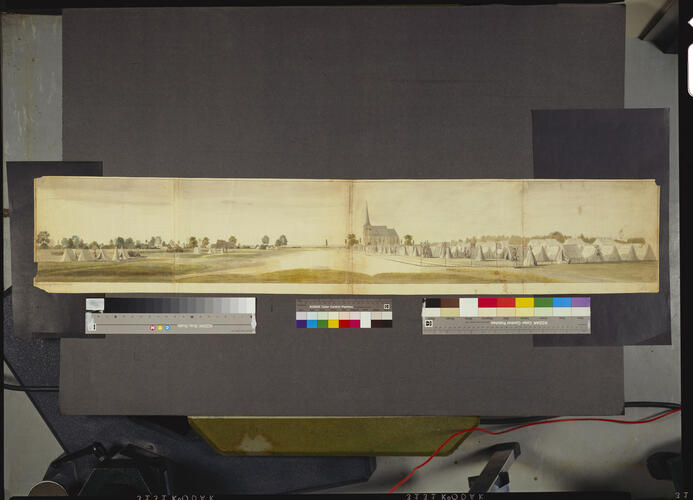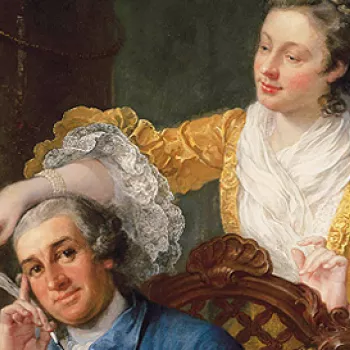A British Camp at Eindhoven 1748
Pencil, pen and ink and watercolour | 24.5 x 132.0 cm (sheet of paper) | RCIN 914728
-
A pen and ink and watercolour drawing of an army camp, with tents on the right, a church in the middle distance, and a village green. Soldiers in red coats, and the tents with Union Jack flags. On four sheets of paper, joined vertically, Villedary watermark. Signed below on the left in pen and ink, 'Drawn on the spot, by T. Sandby July 5th 1748', and inscribed on the verso in pencil, '2 [illegible] at Kenilworth in Warwicks', with a dealer's cypher lower right.
Thomas Sandby trained as a military draughtsman at the Board of Ordnance, and worked for three years at their drawing room in Edinburgh before entering the employ of William Augustus, Duke of Cumberland during his campaign to defeat the Jacobites, concluding with the Battle of Culloden in 1746. An apocryphal anecdote first recorded by the critic John Williams suggests that it was Sandby who 'conveyed the intelligence of the [landing of the Young Pretender] to the Government in the year 1745' (see J. Bonehill and S. Daniels (eds), Paul Sandby: Picturing Britain, exh. cat., Royal Academy etc 2009, p. 78). Sandby also travelled with the Duke's party to the Netherlands in 1747-8 during the final stages of the War of Austrian Succession.
Here Sandby shows the Coldstream Guards' Camp at Eindhoven. A drawing for the tent is among the drawings by Paul Sandby at the V&A. Oppé notes that the dealer's inscription of 'Kenilworth' probably mistakes a Flemish place name. Two further drawings by Sandby made in the Netherlands are RCINs 914726 and 914727.Provenance
Probably acquired by George IV; Royal Collection by 1892 (listed in W. Sandby, Thomas and Paul Sandby, London, 1892, p. 212)
-
Creator(s)
-
Medium and techniques
Pencil, pen and ink and watercolour
Measurements
24.5 x 132.0 cm (sheet of paper)
Object type(s)
Subject(s)
Other number(s)
RL 14728











